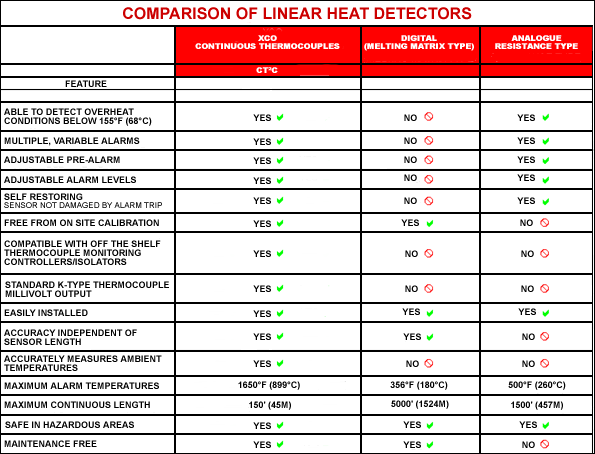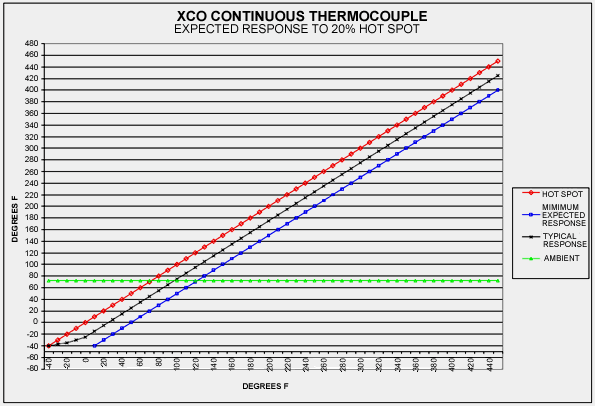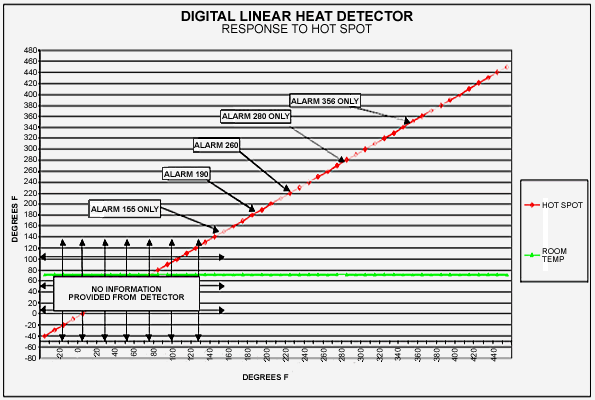|
|||||||||||||||
| Xco -> Continuous Thermocouples -> Comparison of Linear Heat Detectors |
Comparison of Linear Heat DetectorsFollowing is a comparison of the 3 basic types of Linear Heat Detectors:
 Types of heat detectors and their features: 1. Continuous Thermocouples, CT²CCT²C are not simply fire alarms. CT²C contain a pair of type K thermocouple grade wires with a negative temperature coefficient insulation between them. Essentially, each cable has an infinite number of potential temperature measuring junctions along its entire length. See our "How it Works" page for more details.This means that CT²C will continuously measure and report ambient temperature existing in large areas and detect differential temperatures (hot spots) when they occur. Advantages of CT²C include: SAFE: Factory Mutual Research has classified CT²C as simple apparati. As a simple apparatus each Continuous Thermocouple® is intrinsically safe, precluding the need for separate approval in the United States or Europe when used with approved safety barriers. SELF-GENERATING: Requires no external power ACTIVE: Provides accurate real-time ambient temperature information ADJUSTABLE: Provides information for an infinite variety of early warning, pre-alarms and rate of rise alarms. SELF-RESTORING: Is not destroyed and returns to normal after temperature excursions COMPATIBLE WITH MANY STANDARD INSTRUMENTS: K-type millivolt signal MAINTENANCE FREE: Does not require adjustment or periodic calibration UNAFFECTED BY COLD WEATHER: Can detect overheat conditions to -40°F or C At Ambient: When 100% of the cable is heated (ambient temperature) continuous thermocouples respond within the ITS 90 K SCALE Thermocouple Standard of +0 / -2°C. When exposed to Differential Heating: When 20% of the cable is exposed to a "Hot Spot" temperature continuous thermocouples respond within +0°C-16°C.  2. Digital (Single Set Point, Fixed) Linear Heat DetectorsA non-integrating Linear Heat Detector which consists of two actuators (wires) individually insulated in a heat sensitive material that melts at a specific, non-adjustable temperature. A device is connected to one end of the actuators so a small electrical current passes continuously through the detector and supervisory circuit. The heat sensitive material melts at the single rated alarm temperature allowing contact between the wires. Three (3) different detectors are offered, each with a single, non-adjustable (fixed) temperature rating.Each will operate ONLY at its SPECIFIC, NON-ADJUSTABLE alarm temperature set point. Until that specific alarm temperature is reached, the sensor is absolutely MUTE. The fixed temperatures are: 155°F (68.3°C) or 190°F (87.8°C) or 220°F (105°C) or 280°F (137.8°C) or 356°F (180°C) See how Single Set Point type of cable compares to continuous thermocouples in an actual fire situation. This is particularly important in Cold Storage Facilities where product loss can occur far below 155°F.  3. Resistive Type Linear Heat DetectorsA sensor whose conductors are covered with a negative temperature coefficient insulation material. An increase in temperature lowers the resistance of the insulation and this change is interpreted by an interface module which activates an alarm at a pre-set resistance level.The sensor cable responds to a localized drop in resistance from a hot spot OR an overall drop in resistance from a low level ambient temperature increase over its total length (but cannot tell which is occurring). In an example offered by one manufacturer: A 300 foot sensor operating in an ambient temperature of 120°F with a 145°F alarm setting. "An alarm will be initiated if the temperature over the entire sensor averages 145°F. Higher temperatures would be needed to initiate an alarm over shorter sections of the entire sensor length." Under these conditions, a 100 foot "localized hot spot" with a temperature of 165°F would be required to cause an alarm, even though the alarm temperature setting is only 145°F. 30 feet at 180°F would be required to activate the 145°F alarm. 208°F would be required over 15 feet to activate the 145°F alarm. But what would happen if the ambient temperature dropped to 100°F? A 100 foot "localized hot-spot" would require a temperature of 195°F to activate the 145°F alarm. With a 30 foot "localized hot spot" the temperature required to activate the 145°F alarm jumps to 230°F. 277°F is required to activate the 145°F alarm if 15 feet of the sensor is exposed to a "localized hot-spot". Also, with the integrating (resistance averaging) Linear Heat Detector, POWER must be supplied to EACH sensor from a junction box and/or a special dedicated control panel. |